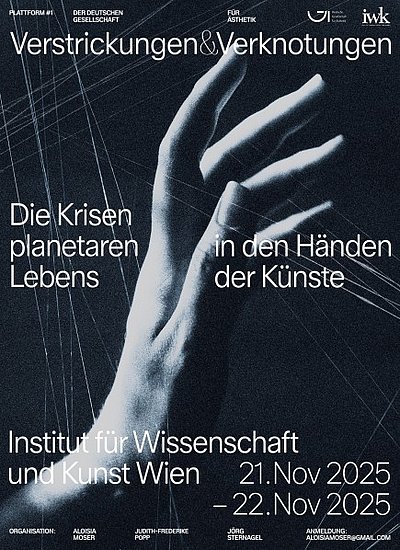Welcome at the Interface Culture program website.
Acting as creative artists and researchers, students learn how to advance the state of the art of current interface technologies and applications. Through interdisciplinary research and team work, they also develop new aspects of interface design including its cultural and social applications. The themes elaborated under the Master's programme in relation to interactive technologies include Interactive Environments, Interactive Art, Ubiquitous Computing, game design, VR and MR environments, Sound Art, Media Art, Web-Art, Software Art, HCI research and interaction design.

The Interface Culture program at the Linz University of Arts Department of Media was founded in 2004 by Christa Sommerer and Laurent Mignonneau. The program teaches students of human-machine interaction to develop innovative interfaces that harness new interface technologies at the confluence of art, research, application and design, and to investigate the cultural and social possibilities of implementing them.
The term "interface" is omnipresent nowadays. Basically, it describes an intersection or linkage between different computer systems that makes use of hardware components and software programs to enable the exchange and transmission of digital information via communications protocols.
However, an interface also describes the hook-up between human and machine, whereby the human qua user undertakes interaction as a means of operating and influencing the software and hardware components of a digital system. An interface thus enables human beings to communicate with digital technologies as well as to generate, receive and exchange data. Examples of interfaces in very widespread use are the mouse-keyboard interface and graphical user interfaces (i.e. desktop metaphors). In recent years, though, we have witnessed rapid developments in the direction of more intuitive and more seamless interface designs; the fields of research that have emerged include ubiquitous computing, intelligent environments, tangible user interfaces, auditory interfaces, VR-based and MR-based interaction, multi-modal interaction (camera-based interaction, voice-driven interaction, gesture-based interaction), robotic interfaces, natural interfaces and artistic and metaphoric interfaces.
Artists in the field of interactive art have been conducting research on human-machine interaction for a number of years now. By means of artistic, intuitive, conceptual, social and critical forms of interaction design, they have shown how digital processes can become essential elements of the artistic process.
Ars Electronica and in particular the Prix Ars Electronica's Interactive Art category launched in 1991 has had a powerful impact on this dialog and played an active role in promoting ongoing development in this field of research.
The Interface Cultures program is based upon this know-how. It is an artistic-scientific course of study to give budding media artists and media theoreticians solid training in creative and innovative interface design. Artistic design in these areas includes interactive art, netart, software art, robotic art, soundart, noiseart, games & storytelling and mobile art, as well as new hybrid fields like genetic art, bioart, spaceart and nanoart.
It is precisely this combination of technical know-how, interdisciplinary research and a creative artistic-scientific approach to a task that makes it possible to develop new, creative interfaces that engender progressive and innovative artistic-creative applications for media art, media design, media research and communication.
Verstrickungen und Verknotungen
21. bis 22. November 2025 iwk - Institut für Wissenschaft und Kunst, Wien
Die Krisen planetaren Lebens in den Händen der Künste
Vorträge im Rahmen der Konferenz von Lehrenden der Kunstuniversität Linz:
Sarah Kolb | »To Knot or Not to Knot. On Artistic Research, Mathematical Relations, and Fungal Entanglements«
Silke Felber | Making Sense: Klimaungerechtigkeit und ihre multisensorischen Resonanzräume«
Organisiert von Aloisia Moser, Judith-Frederike Popp und Jörg Sternagel / Deutsche Gesellschaft für Ästhetik iwk – Institut für Wissenschaft und Kunst, Wien, AT.
Vorläufiges Programm
Tag 1: Freitag, 21. November 2025
09.30 bis 10.00 Uhr: Begrüßung und Einführung. Welcome and Introduction
10.00-12.00 Uhr: Panel 1: Lokalisierungen und Dezentrierungen. Localizations and Decentrations
Esther Hutfless (Sigmund Freud PrivatUniversität Linz), »The non-/in-human within? Psychoanalyse und das nicht- und mehr-als-menschliche Andere«
Kathrin Kazmaier (Universität Hildesheim), »Von gefallenen Göttern und gefüllten Tragetaschen. Literarische Perspektiven eines anderen Zusammenlebens«
Moderation: tba
12.00 bis 13.00 Uhr: Mittagspaus
13.00 bis 16.00 Uhr: Panel 2: Körperlichkeit und Angreifbarkeit. Physicality and Vulnerability
Petja Ivanova (Studio for Poetic Futures & Speculative Ecologies, Berlin), »Wounded Portals and Somatic Entanglements: Artistic Practices Toward a Poetic Ecology of Feeling«
Isabella Schlehaider (Akademie der bildenden Künste Wien), »›Anders Angst haben‹ – Zur ästhetischen Qualität und Funktion von Theorien bei Whitehead, Haraway und Stengers«
Xu Zhao (Università di Padova), »Embodied Crisis: Butoh as Ecological and Existential Resistance«
Moderation: tba
16.00 bis 16.30 Uhr: Kaffeepause
16.30 bis 17.30 Uhr: Gemeinsame Gesprächsrunde. Joint Discussion.
18.00 Uhr: Abendessen
Tag 2: Samstag, 22. November 2025
10.00 bis 12.00 Uhr: Panel 3: Pflanzlichkeit und Sinnlichkeit. Plantiness and Sensuality
Isabel Kranz (Universität für angewandte Kunst Wien), »Promising Plants: Das Heilsversprechen der Pflanzen in Gegenwartsliteratur und -kunst«
Silke Felber (Kunstuniversität Linz Abteiling Kulturwissenschaft), »Making Sense: Klimaungerechtigkeit und ihre multisensorischen Resonanzräume«
Moderation: tba
12.00 bis 13.00 Uhr: Mittagspause
13.00 bis 16.00 Uhr: Panel 4: Verstrickungen und Verknotungen. Entanglements and Knots
Sarah Kolb (Kunstuniversität Linz, Abteilung Kunstgeschichte und Kunsttheorie), »To Knot or Not to Knot. On Artistic Research, Mathematical Relations, and Fungal Entanglements«
Nick Psomas (Universiteit van Amsterdam), »Speculative Poetics of Planetary Entanglements in Édouard Glissant and Theodor W. Adorno«
Sophie Ramm (Technische Universität Wien), »Conversations between Architecture and Painting: Gerunds of Operative Materiality of an Investigative Rationalism«
Moderation: tba
16.00 bis 16.30 Uhr: Kaffeepause
16.30 bis 17.30 Uhr: Abschlussdiskussion. Closing Discussion
